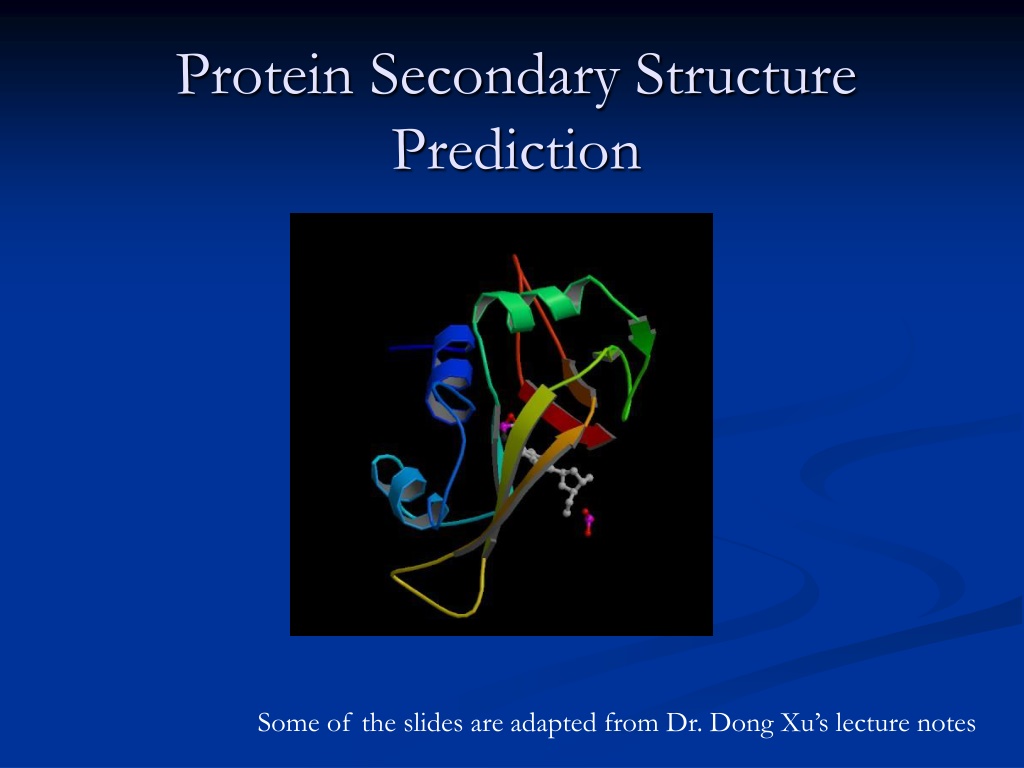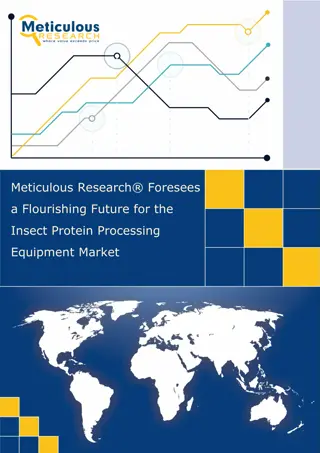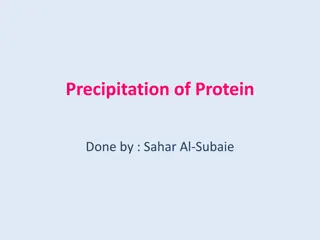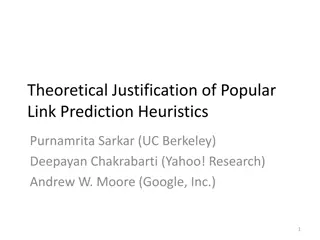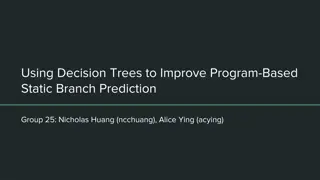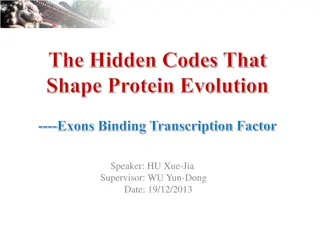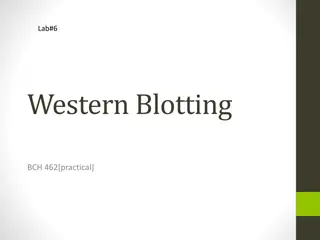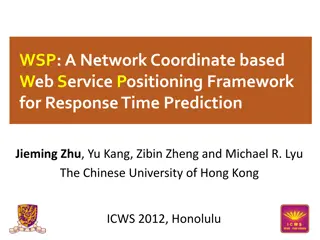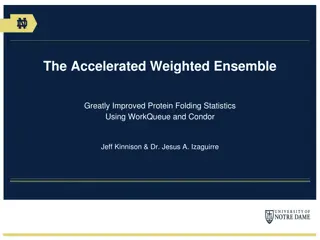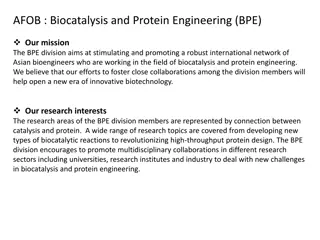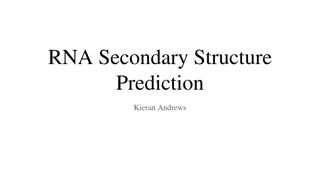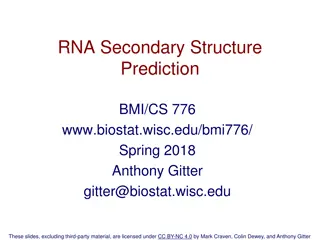Protein Secondary Structure Prediction: Insights and Methods
Accurate prediction of protein secondary structure is crucial for understanding tertiary structure, predicting protein function, and classification. This prediction involves identifying key elements like alpha helices, beta sheets, turns, and loops. Various methods such as manual assignment by crystallographers and automated tools like DSSP, STRIDE, and Continuum are employed for assigning secondary structure. Understanding the secondary structure provides valuable information for predicting protein structure changes and has been an active field of research for over 40 years.
Download Presentation

Please find below an Image/Link to download the presentation.
The content on the website is provided AS IS for your information and personal use only. It may not be sold, licensed, or shared on other websites without obtaining consent from the author. Download presentation by click this link. If you encounter any issues during the download, it is possible that the publisher has removed the file from their server.
E N D
Presentation Transcript
Protein Secondary Structure Prediction Some of the slides are adapted from Dr. Dong Xu s lecture notes
Why secondary structure prediction? Accurate secondary structure prediction can be an important information for the tertiary structure prediction Protein function prediction Protein classification Predicting structural change An easier problem than 3D structure prediction (more than 40 years of history).
helix -helix (30-35%) Hydrogen bond between C=O (carbonyl) & NH (amine) groups within strand (4 positions apart) 3.6 residues / turn, 1.5 rise / residue Typically right hand turn Most abundant secondary structure -helix formers: A,R,L,M,E,Q,K
sheet & turn -sheet / -strand (20-25%) Hydrogen bond between groups across strands Forms parallel and antiparallel pleated sheets Amino acids less compact 3.5 between adjacent residues Residues alternate above and below -sheet -sheet formers: V,I,P,T,W -turn Short turn (4 residues) Hydrogen bond between C=O & NH groups within strand (3 positions apart) Usually polar, found near surface -turn formers: S,D,N,P,R
-sheet (parallel, anti-parallel)
Others Loop (bridging region) Regions between -helices and -sheets On the surface, vary in length and 3D configurations Do not have regular periodic structures Loop formers: small polar residues Coil (40-50%) Generally speaking, anything besides -helix, -sheet, -turn
Assigning Secondary Structure Defining features Dihedral angles Hydrogen bonds Geometry Assigned manually by crystallographers or Automatic DSSP (Definition of secondary structure of proteins, Kabsch & Sander,1983) STRIDE (Frishman & Argos, 1995) Continuum (Claus Andersen, Burkhard Rost, 2001)
Definition of secondary structure of proteins (DSSP) The DSSP code H = alpha helix B = residue in isolated beta-bridge E = extended strand, participates in beta ladder G = 3-helix (3/10 helix) I = 5 helix (pi helix) T = hydrogen bonded turn S = bend CASP Standard H = (H, G, I), E = (E, B), C = (T, S)
Secondary Structure Prediction Given a protein sequence (primary structure) GHWIATRGQLIREAYEDYRHFSSECPFIP Predict its secondary structure content (C=Coils H=Alpha Helix E=Beta Strands) GHWIATRGQLIREAYEDYRHFSSECPFIP CEEEEECHHHHHHHHHHHCCCHHCCCCCC
Prediction Methods Single sequence Examine single protein sequence Base prediction on Statistics composition of amino acids Neural networks patterns of amino acids Multiple sequence alignment First create MSA Use sequences from PSI-BLAST, CLUSTALW, etc Align sequence with related proteins in family Predict secondary structure based on consensus/profile Generally improves prediction 8-9%
Accuracy Correctly predicted residues/total residues Statistical method (single sequence) 1974 Chou & Fasman 1978 Garnier Statistical method (Multiple sequences) 1987 Zvelebil 1993 Yi & Lander Neural network 1988 Qian & Sejnowski 1993 Rost & Sander 1997 Frishman & Argos 1999 Cuff & Barton 1999 Jones 2000 Petersen et al. ~50-53% 63% 68% 66% 64.3% 70.8-72.0% <75% 72.9% 76.5% 77.9%
Assumptions The entire information for forming secondary structure is contained in the primary sequence. Side groups of residues will determine structure. Examining windows of certain number of residues is sufficient to predict structure. Basis for window size selection: a-helices 5 40 residues long b-strands 5 10 residues long
Algorithm Chou-Fasman Method Examining windows of 5 - 6 residues to predict structure
Secondary structure propensity From PDB database, calculate the propensity for a given amino acid to adopt a certain ss-type Index of aa ss Example: #Ala=2,000, #residues=20,000, #helix=4,000, #Ala in helix=500 P=?
http://intro.bio.umb.edu/111-112/111F98Lect/folding.html http://www.cs.ucl.ac.uk/staff/D.Jones/t42morph.html http://www.youtube.com/watch?v=GzATbET 3g54&mode=related&search=
CS Day http://www.cs.uakron.edu/~csday/ Complete and e-mail to csday@cs.uakron.edu by Friday April 13
Secondary structure propensity From PDB database, calculate the propensity for a given amino acid to adopt a certain ss-type Example: #Ala=2,000, #residues=20,000, #helix=4,000, #Ala in helix=500 P( ,aai) = 500/20,000, p( ) = p(aai) = 2,000/20,000 = 500 / (4,000/10) = 1.25
Chou-Fasman parameters Note: The parameters given in the textbook are 100*P i
Chou-Fasman algorithm Helix: Scan through the peptide and identify regions where 4 out of 6 contiguous residues have P(H) > 1.00. That region is declared an alpha-helix. Extend the helix in both directions until a set of four contiguous residues that have an average P(H) < 1.00 is reached. That is declared the end of the helix. If the segment defined by this procedure is longer than 5 residues and the average P(H) > P(E) for that segment, the segment can be assigned as a helix. Repeat this procedure to locate all of the helical regions in the sequence.
Initiation Identify regions where 4/6 have a P(H) >1.00 alpha-helix nucleus T 69 S 77 P 57 T 69 A 142 E 151 L 121 M 145 R 98 S 77 T 69 G 57 P(H) T 69 S 77 P 57 T 69 A 142 E 151 L 121 M 145 R 98 S 77 T 69 G 57 P(H)
Propagation Extend helix in both directions until a set of four residues have an average P(H) <1.00. T 69 S 77 P 57 T 69 A 142 E 151 L 121 M 145 R 98 S 77 T 69 G 57 P(H) If the average P(H) > P(E) for that segment, the segment can be assigned as a helix.
Chou-Fasman algorithm B-strand: Scan through the peptide and identify a region where 3 out of 5 of the residues have a value of P(E)>1.00. That region is declared as a beta-sheet. Extend the sheet in both directions until a set of four contiguous residues that have an average P(E) < 1.00 is reached. That is declared the end of the beta-sheet. Any segment of the region located by this procedure is assigned as a beta-sheet if the average P(E)>1.05 and the average P(E)>P(H) for that region. Any region containing overlapping alpha-helical and beta-sheet assignments are taken to be helical if the average P(H) > P(E) for that region. It is a beta sheet if the average P(E) > P(H) for that region.
Chou-Fasman algorithm Beta-turn To identify a bend at residue number j, calculate the following value p(t) = f(j)f(j+1)f(j+2)f(j+3) If (1) p(t) > 0.000075, (2) the average value for P(turn) > 1.00 in the tetrapeptide and (3) the averages for the tetrapeptide obey the inequality P(H) < P(turn) > P(E), then a beta-turn is predicted at that location.
Exercise Predict the secondary structure of the following protein sequence: Ala Pro Ala Phe Ser Val Ser Leu Ala Ser Gly Ala 142 57 142 113 77 106 77 121 142 77 57 142 83 55 83 138 75 170 75 130 83 75 75 83 66 152 66 60 143 50 143 59 66 143 156 66
Neural network training Compare Prediction to Reality Adjust Weights Enter sequences
Neural net for secondary structure D (L) R (E) Q (E) A C D E F G H I K L M N P Q R S T V W Y . G (E) F (E) H V (E) E P (E) A (H) L A (H) Y (H) V (E) K (E) K (E)
Neural net for SS Prediction Jury decisions Use multiple neural networks & combine results Average output Majority decision
Neural net for SS Prediction JPRED [Cuff+ 1998] Finds consensus from PHD, PREDATOR, DSC, NNSSP, etc
